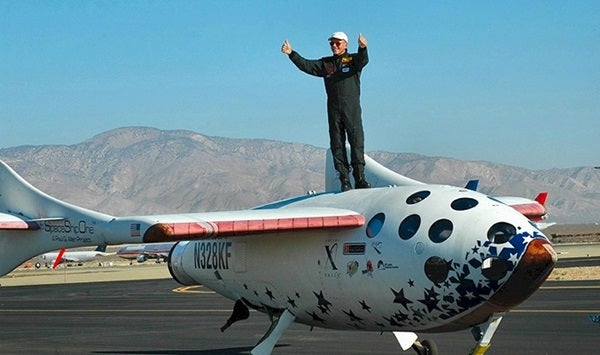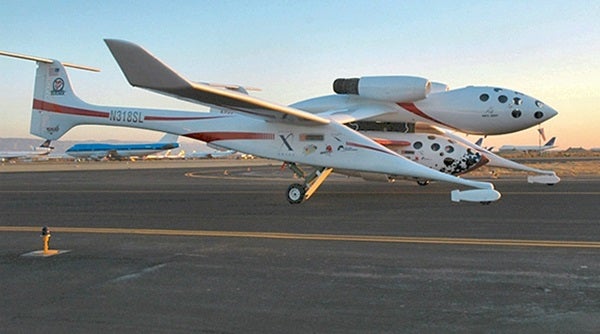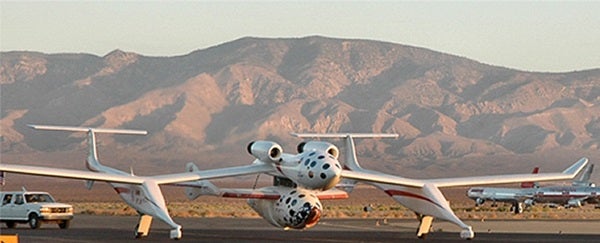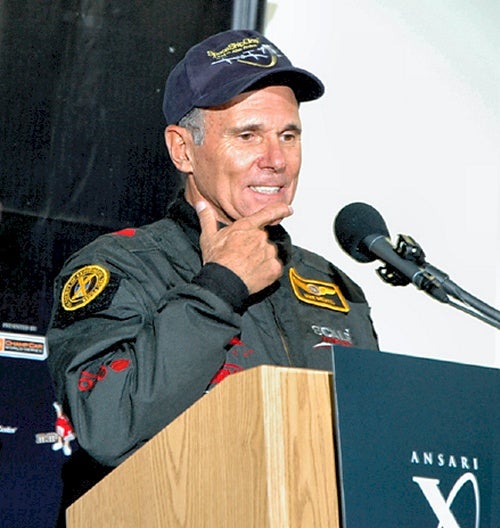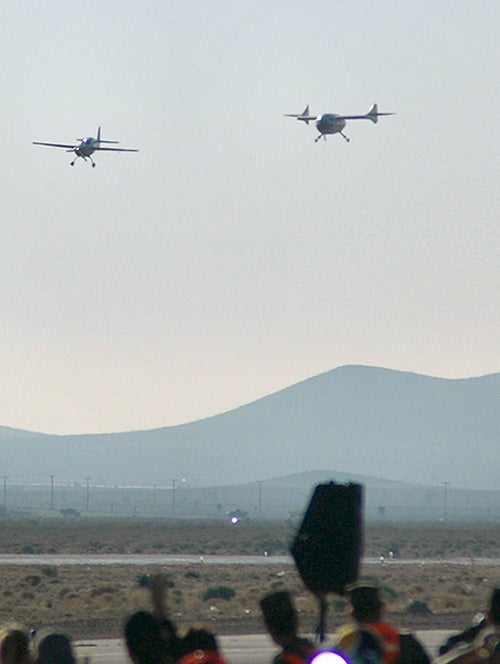Suborbital space rides came one step closer to reality September 29. Under the Full Moon, thousands of camping spectators waited patiently outside what is now being called Mojave Spaceport, a civilian aerospace testing center in Mojave, California, to witness the latest launch of SpaceShipOne. Volunteers operated souvenir and food stands throughout the early morning hours, while a star-struck multitude gathered and shared stories. Some people reminisced about space watching in 1981, when the first space shuttle landed at Edwards Air Force Base just a few miles away. For others, SpaceShipOne is their generation’s first rendezvous with space exploration.
On June 21, SpaceShipOne became the first privately funded manned spacecraft to reach suborbital space when it climbed to an altitude of 328,000 feet (100 kilometers). This flight made pilot Mike Melvill the first commercial civilian astronaut.
Surpassing that height — to 337,500 feet (103 km) — this Wednesday, SpaceShipOne soared into history again, completing its first milestone toward winning the $10 million Ansari X-Prize. The prize is to be awarded to the first privately funded piloted spaceship able to loft the equivalent weight of three people to an altitude of 62 miles (100 km) — and do so twice in two weeks.
At approximately 7:00 a.m. PST, a manned twin-turbojet aircraft called White Knight carried SpaceShipOne down the runway. Pilot Mike Melvill opened one of the craft’s portholes and waved to the cheering crowd just before takeoff. Logos from sponsors like M&M, 7UP, and Virgin Galactic now adorn both the rocket and its mother ship — an addition made after their inaugural flight — and both vehicles have plenty of room for more.
To meet the X-Prize competition’s three-person weight requirement, the craft carried an eclectic array of objects totaling 360 lbs. — from employee tools to a plaque bearing the names of X-Prize donors — in addition to its pilot.
After a slow runway roll for the crowd, the White Knight returned at full speed and was airborne when it streaked past the media and VIP stage — the start of her hour-long journey to deliver SpaceShipOne. The White Knight climbed in circles above the crowd to approximately 48,000 feet (14.6 km). There, it released SpaceShipOne and Melvill fired the craft’s hybrid rocket motor. Spectators on the ground got a perfect view of the contrail as the spaceship screamed upward.
Melvill shut down the motor after 77 seconds — just 1 second longer than the June 21 flight, but 11 seconds earlier than planned. Melvill was prepared to burn the motor up to 89 seconds but didn’t need to after he noted the altitude predictor exceeded the required 62-mile (100 km) mark.
“The rocket ran like a dream,” Melvill said. After the flight, he stood atop the spacecraft as it was towed along the runway and stopped at the media section. “That engine would have done 11 more seconds. How high that would have been,” he mused. Addressing Frank Macklin, vice president of engineering at SpaceDev, a Poway, California, company, Melvill added “Frank, great engine, man.” SpaceDev developed SpaceShipOne’s rocket motor and is designing its own spacecraft — called Dream Chaser — based on the same technology.
Peter Diamandis founded the Ansari X-Prize in 1996. Named for the Ansari family of Dallas, Texas, and funded through private donations and corporate sponsorships, the X-Prize is a $10 million purse aimed at jump-starting space tourism. The goal is similar to that of the $25,000 Orteig Prize, which inspired Charles Lindbergh’s 1927 solo flight across the Atlantic Ocean. Organizers hope the X-Prize will spur a new age of commercial space exploration just as the Orteig Prize contributed to the beginning of commercial air flight.
To win the X-Prize, one of the 26 competing teams must successfully launch the weight equivalent of three humans to a suborbital altitude of 100 km (62 miles) in a reusable spacecraft twice within 2 weeks. As part of the challenge, all of this must be accomplished by January 1, 2005.
Wednesday’s launch was the first official X-Prize launch to date by any of the 26 teams. SpaceShipOne was developed by the American Mojave Aerospace Ventures team, which is led by aviation legend Burt Rutan of Scaled Composites and financed by Microsoft cofounder Paul G. Allen. The group has been the developmental front-runner in the competition and needs only one more successful flight to win. The next flight is scheduled for October 4.
Also this week, Sir Richard Branson, chairman of Virgin Group Ltd., announced a licensing agreement with Mojave Aerospace Ventures to manufacturer multiple spacecraft based on the SpaceShipOne design. The new business, dubbed Virgin Galactic, plans to begin flights as early as 2007. Pricing will start around $200,000 a seat and the company anticipates having at least 3,000 customers during the first few years.
The Mojave team’s closest competition for the X-Prize is Canada’s Golden Palace.com Space Program developed by the da Vinci Project. The Canadian team last week postponed a flight planned October 2, and a new date has not been announced.
To find out if SpaceShipOne proves worthy of the $10 million prize, watch October 4 in Mojave, California. The event is open to the public for a small fee, which goes to the X-Prize Foundation. For those unable to attend, the flight will be webcast free at www.xprize.org/webcast and is currently scheduled for 6 a.m. PST.

